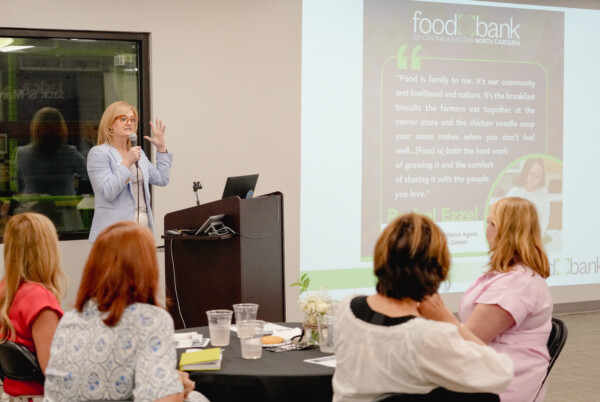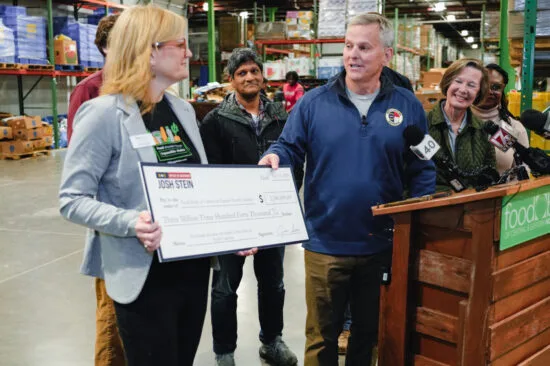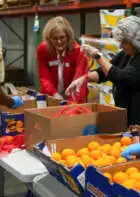Longtime supporters and community leaders gathered in Raleigh and Wilmington to discuss new strategies to meet rising hunger challenges.
The occasion? Welcoming Amy Beros home as the Food Bank’s new President & CEO.
Amy Beros is a lifelong anti-hunger advocate with decades of experience advancing community-centered solutions at the local and national level — including leadership roles at the Food Bank and Feeding America. So when longtime supporters and community leaders gathered at Food Bank branches recently as part of our ‘Meet the CEO’ series, the conversation was far from surface level. It was an opportunity to dig deep into rising hunger challenges and the systemic strategies needed to meet this crisis head-on.
We had a chance to sit down with Amy and pick up on a host of issues that were raised at the events — including hunger trends, government funding cuts, and even opportunities presented by AI.
As many of us know too well, our communities face a worsening hunger crisis. The latest data shows that more than 600,000 people face hunger right now across central and eastern North Carolina. That number was 450,000 just a couple years ago.
To put these figures into context, that’s 1 out of every 7 neighbors we run into at the grocery store or out pumping gas. It’s 1 in 5 kids and teens we see at school pick-up. And the challenges are even deeper in communities that have faced barriers and exclusion for generations.
Though the research may be new, it really only validates the reality hunger relief organizations have experienced on the ground for many months now. Across our network of 700+ local pantries, meal sites, and no-cost markets, visits are up 20% to 60%. Many locations are seeing more people than we did at the peak of the pandemic.
And all this is happening at a time when our most critical safety net programs are shrinking. It is simply unacceptable.
Like so many food banks and communities across the country, we continue to navigate deep cuts to longtime successful federal programs and funding sources. Many people don’t realize how intertwined our food assistance network is with federal agriculture, public health, and nutrition policies:
- Nearly 20% of the food we distribute can be traced back to federal sources
- A significant portion of the fresh fruits and vegetables we provide come from local farms who are facing real challenges due to new tariffs and funding cuts
- And much of the funding we use to purchase and distribute locally sourced foods ultimately comes from the federal government
In March, the Administration announced the elimination of all Local Food Purchase Agreements and Local Food for Schools funding planned for 2025 and beyond. For our Food Bank, this meant a $2 million cut to local food purchase funding, on top of a $375K cut in annual funding to store, transport, and distribute USDA foods. Despite agreements that go back years or even decades, these costs now fall on our shoulders.
The massive funding cuts don’t just impact the Food Bank’s bottom line; this is millions of dollars in lost revenue for local farms. Between direct relationships and our work with regional Food Hubs, we purchase locally-grown and -raised food from more than 80 small farms with this funding — and many local growers and producers have said that these programs have allowed their family farms to stay open. Without this funding, we may see some of the farmers who produce our food needing support from local pantries and meal sites.
No matter what changes may come, we remain committed to our partnerships with North Carolina farmers. We’re doing all we can to increase state investments and raise private funds to maintain this critical source of healthy, locally grown food.
If we take a look at the statewide picture, more than 1.6 million people face food insecurity across North Carolina — the highest in nearly 20 years.
Our food assistance network is moving mountains to meet this rising need, with hundreds of local organizations working together to distribute over 250 million meals each year in communities across the state. But even at that scale, for every meal our network distributes, the Supplemental Nutrition Assistance Program (SNAP or FNS) provides nine.
Even so, politicians in Washington recently passed the largest cut to SNAP in the program’s history. As a result, North Carolina families will lose as much as $700 million in direct grocery support in the coming years. That’s a huge cut to the funds 1.4 million people in our state rely on to keep food on the table — including children, seniors, veterans, and working adults. It’s also a huge hit to local economies: every $1 in SNAP generates $1.50+ in economic activity that supports farmers, grocers, and jobs.
Inflation has pushed food prices out of reach for far too many families. Healthy options like fresh fruit, vegetables, meat, and eggs are among the most expensive items at grocery stores right now. At the same time, politicians have voted to reduce families’ grocery budgets even further, pointing to our emergency food assistance networks as an alternative.
These actions have created enormous gaps in the federal safety net — gaps that we’ll do all we can to fill. But we know food banks can’t do it through charity alone; we need state and federal officials to step up and mitigate these cuts.
As of August 1, we still don’t have a full two-year state budget — and over $9 million in food bank funding hangs in the balance. We’re proud of the wide, bipartisan support we’ve earned in prior budgets for funds dedicated to purchasing food from local farms and small businesses. And though we’ve heard from several legislators that food purchase funds remain a priority, unrelated disagreements between the House and Senate have placed this funding in jeopardy.
Even if the General Assembly manages to pass a budget later this fall, the impasse has already had serious effects on families facing hunger. The lack of a renewed state commitment to Healthy Opportunities Pilots has cost North Carolina more $225 million in federal funding for food assistance, affordable housing, and other supports for patients with complex medical conditions. As a result, hunger relief programs across the state are winding down distribution of medically-tailored meals, healthy food boxes, and ‘Fruit & Veggie Rx’ availability that were covered by the program.
With such deep cuts to federal programs and funding this year, state-level investments are even more important. We continue to push the General Assembly to prioritize hunger relief in budget negotiations.
Even with government funding cuts and more people turning to us for help, we’re standing strong. The Food Bank network will be here, no matter what.
Our staff shows up every day with heart and determination, finding new ways to keep food flowing to those who need it most. We’re working harder than ever to fill the gaps and build lasting change in the fight against hunger.
We’re also lifted by the incredible support of thousands of volunteers. Volunteers give their time and energy without hesitation — packing boxes, sorting produce, and helping at distributions. It’s their passion and drive that keep us moving forward during tough times.
And of course our generous donors continue to show up for our community. Their powerful combination of dedication, generosity, and community spirit is what fuels our work. Together, we’ll get through this — and come out stronger on the other side.
All signs point to the Administration and Congress continuing to step away from hunger relief programs. And the most recent round of cuts to Medicaid and SNAP funding will no doubt place a singificant strain on the state budget as well. The work we do with cities and counties is more important than ever, and local governments are the bridge between urgent community needs and lasting solutions. I see three key opportunities to advance our shared mission through local partnerships:
The most obvious may be to invest local funding in hunger relief efforts. City and county leaders can use local budgets to support food banks and community organizations that support families. This funding can help buy more food, improve storage and delivery, and keep food distributions going in areas that need it most. Even small contributions can make a big difference when added to philanthropic support.
Cities and counties can also make a big difference in improving local food access. Even a small investment in tangible infrastructure like delivery trucks, storage space, or mobile food pantries has an outsized impact in keeping food available in your community. There are also opportunities to support local farmers and food businesses — helping them sell fresh, healthy food to schools and neighborhoods that need it.
And perhaps most importantly: we need your voice. Members of Congress and the General Assembly depend on your expertise and advice. When you have their ear, shine a light on hunger in your community. Share the local impact of an upcoming vote or bill that was recently signed into law. Tell them how decisions on SNAP, or school meals, or Healthy Opportunities are playing out on the ground . By raising awareness and elevating local organizations, you can help make hunger a priority and move solutions forward.
From predictive modeling to data-informed storytelling, there are a few ways we’re already using AI to inform our work. Two quick examples:
- We’re incredibly fortunate to have more than 50,000 financial supporters throughout the region. That’s a lot of people (and a lot of data!), and we do everything possible to match donors with opportunities that align with their interests. Machine learning helps make that possible, and it also helps predict when and what types of donations are likely to be received.
- We’ve piloted new inventory management tools that will make it much easier for partner agencies to receive the products they need, when they need them. AI helps us predict the best mix of shelf-stable vs. perishable items, makes a more efficient ordering processs, and helps align supply with expected demand — which minimizes shortages and waste.
We also know the potential of these tools grows every day, and we’re thinking of other ways AI can help us better serve the community.
- Combining distribution history, community demographics, and economic trends, could better predict demand for food down to specific zip codes or product types.
- Analyzing prior volunteer shifts and seasonal changes may help forecast future turnout or gaps that need additional recruitment effort.
- AI can cross-reference our service records with public datasets like SNAP participation and census responses to identify geographic or demographic service gaps — or even transform datapoints into trends that reinforce community stories.
The possibilities are really endless.
Between rising hunger and funding uncertainty, the coming years are likely to be unlike anything we’ve experienced in generations. It’s going to take all we have to keep food flowing to communities that need it most, while maintaining our focus on long-term solutions.
That’s why our 2030 strategic planning process is guided by one key question: how do we ensure access to food today while also helping build a future where people don’t have to worry about their next meal? And though conversations are just getting underway, we already know of several pillars that will be key to our success in reducing hunger over the coming years
- Infrastructure: We’re already investing in smarter, more resilient systems — from local sourcing, to mobile units, to disaster response — to ensure fresh, versatile food reaches communities as quickly as possible
- Community partnerships: We must listen to the experts — people facing hunger — and pursue local solutions that best reflect each community’s needs.
- Advocacy: Our Food Bank network needs to be a stronger voice for policies that fight hunger, as well as public investments at every level of government.
- Data and innovation: With limited resources, we must better tap new technology and data analytics to effectively target, improve impact, and track progress.
- And of course, our people and culture: We’ll continue to support and grow a diverse, mission-driven team who feel valued and prepared to lead.
With our federal government stepping away from key hunger relief programs, community support is more important than ever.
When we’re talking about millions of dollars in funding cuts, the numbers can seem daunting. But the work we do together as individuals, families, and groups make a real difference. We saw the impact of incredible community generosity throughout the pandemic — so we know exactly what we can accomplish when we work together.
Just as we did then, our Food Bank network will continue to meet people facing hunger where they are — and invest every dollar, every meal, and every volunteer hour in the most impactful ways possible.
My ask is that all of us do what we can in this moment. Lend your voice. Share your time. Donate funds and food. Together, we can meet these challenges head-on and make lasting change in our communities.
“My dream to come back and lead the Food Bank was for one main reason: the people. This team, our partners, and each of you, our donors, volunteers, and advocates. You inspire me every day.
This community is the reason we are able to do the important work we do each day – from the thousands of volunteers who walk through our doors, to the individuals and businesses and foundations who donate food and funds, to the hundreds of local partners we work alongside every day — you are all part of this movement.”
-Amy Beros, Food Bank President & CEO





